|
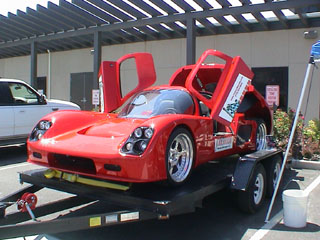
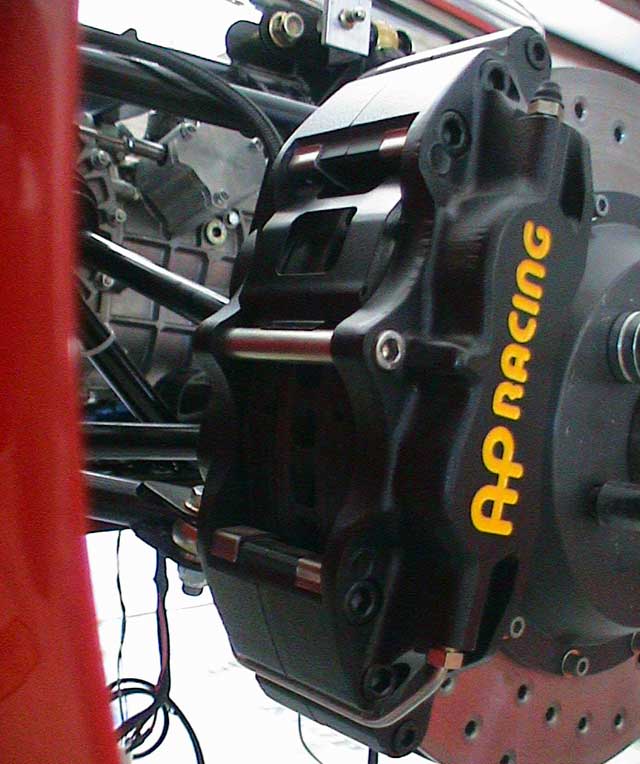

|
|
101 Notes
About Your Track Day
This
is a list of 101 things to learn, prepare, check, take, do at the
track, and do after an event, in chronological order...kind of. The
list covers vehicle and driver prep, what to bring, what to do
the night before and day of the event, between driving
sessions, and after. Of course, you take complete
responsibility for the use of this information. The
information provided by your event's organizer takes precedence
over anything on this website.
Please send us your
suggestions. Your comments are greatly appreciated.
The
goal
of the event organizer is to provide you with a safe and
controlled environment where you can learn and drive your vehicle to its
limits (more accurately, to the driver's limits). There is a good
chance you'll be driving around corners, or entering a braking
zone, at over 100 MPH, even in a Miata. And, because
you'll be sharing the track with other like-minded folks, the #1
concern is safety. This is probably going to be the most fun you've
ever had driving your vehicle, but you can't have this kind of
fun without appropriate safety measures and rules in place --
rules that are uniformly understood and followed by all
participants.
What
should your mindset be? Most high-performance driving
events and education (HPDE) are non-competitive and are not
timed events. You are there to learn vehicle performance
dynamics and improve your driving skills...not to
"race" anyone. There are no trophies for speed
and no trophy girls, no cash prize for winning, and you won't
set a track record. We all have the same goal; to go fast
and have fun safely. So, cooperation and communication
between drivers and with track personnel is paramount.
That said, there may be specific "run groups" that
have a more competitive nature and are timed.
Which
event organizer is right for you? Event organizers
typically rent the track for the days they run. Choose a
track and look at their calendar. You'll see the names, and
perhaps links and contact information, of various
organizers. Visit their websites and give them a
call. Don't hesitate to call the track and talk to
management about the various organizers. Some are more
expensive and include social events, upscale meals, etc.
Some include instruction at no charge. With other groups, everything is
"à la carte". If you don't like your
first choice of organizer, choose another for your second event.
Which
group should I register for? Sign up for the novice group,
if this is a
new experience for you. And, be sure you'll have
instruction. If you are familiar with the track and
attending with a different organizer, perhaps an intermediate
group will work for you. Discuss this with organizer
management well in advance of signing up. Groups are
generally divided by the type of passing rules allowed in the
group; point-by on straights, point-by anywhere, and open
passing anywhere. Also, vehicles in the more advance
groups are often more prepared and faster. Group rules
will be covered in the driver's meetings.
Regardless
of all the stuff below, if your car is in good shape, you should be
able to show up with your helmet and a full tank of gas and have
a great time! Conversely, you don't want to be the guy
holding up the next driving session, because your car stopped
somewhere on the track. So, be as prepared as you
feel comfortable with and get ready to have the best time of
your (driving) life!
-
Vehicle
Log - A good logbook is great for recording
modifications you've made, suspension settings, tire
pressures and temperatures, oil changes and amount used, the
dates of other fluid changes, costs, events, and a host of
other pertinent data. Some groups require one (NASA,
SCCA), but others only require you to fill out and sign a
"tech sheet".
-
Parts
- You want to bring your car home in the same condition it
was when you left (less some rubber). Good
preparation goes a long way towards assuring a trouble-free
event and the longevity of your equipment. As early as
possible before your event, go through the vehicle
and make sure you have on hand, or have ordered, all the
parts you will need to get ready. Procrastinate here
and you'll be scrambling for parts and hurrying through the
work. This usually costs more money and also changes
your mindset. Prepare early. Don't be
rushed. Know you are ready.
-
Vehicle
Prep Tech Sheet - Most HPDE organizers require a "tech
sheet" be completed and turned in to them ahead of, or at,
the morning registration. At SCCA and NASA events, there will
likely be someone inspecting vehicles. Here's an
example of what you can expect to find on a tech
sheet. If you are doing the work yourself, make sure
to have the parts, fluids, fasteners, etc., that you need
well in advance. Don't hurry through the inspection
points, and use a dependable
torque wrench for all fasteners. Don't "fudge
it" with vehicle prep. You will be driving at
much higher speeds, relative to your normal driving.
Speed translates into G-force, higher temperatures, etc.,
which means you will be asking the vehicle's components to
perform closer to their maximum design specifications.
You, and the other drivers on the track, rely on each other
for safe vehicle operations. So, if you are going to
do your own tech inspection, don't skip anything and make
sure you completely understand the requirements and
specifications of your vehicle. Otherwise, get help in the
form of a knowledgeable professional or trusted advisor.
-
Hand
Tools - You can't have too many tools with you.
Luckily, a lot of track event participants feel the same way. So, if you
don't have something, there's a good chance someone in the
paddock will, and most folks are very willing to
share. However, you better be sure to have any
specialty tools with you. Things like C-Spanners for
your coil-overs, special Allen keys, star wrenches, and any
tools you've customized, may be hard to find substitutes
for.
-
Tire
Tools - If there are any special tools needed to remove
wheels and tires, like locking lugs, be sure to have them handy.
Double-check.
-
Lift
Equipment - If you need to get your ride off the ground,
it's always best to have your own lifting equipment.
Even though folks are willing to share, you'll save valuable
time having your own stuff.
-
Oil
Change - Fresh oil = best engine protection. At
most events, you will get lots of track time...probably four
or five
20-minute sessions. A large percentage of that time
will be spent at the upper end of the RPM range, going around
corners, and at WOT (wide-open throttle). Oil is the
life-blood of your engine and chances are good you'll use a
little. It may be appropriate to start your day with
an extra half quart in the engine.
-
Engine
Cooling System - The condition of your cooling system
can mean the difference between driving home or a big towing
bill. The system is comprised of a pump, the coolant,
hot and cold hoses, the radiator and cap, the overflow tank
and hose, probably a heater, heater hoses and control valve(s).
Some cars have coolant hoses running to the throttle body or intake
manifold. Change the coolant if it's been a
while. If required, bleed the air out of the system
after changing. An old radiator cap may not be holding pressure.
-
Brake
Pads, Rotors, Master, Brake Lines and Fluid - Make sure
your brake system is prepared to take the beating. You
are about to demand performance from all of the components. If your
rotors warp when hot, you won't enjoy yourself when the
whole front end starts shaking. If the fluid hasn't
been changed within the last year, do a thorough
bleed. Inspect your lines for any rub marks or
cracking. Make sure you have enough pad thickness for
your event. Carbotech XP8 pads are good down to about
3-4 mm. Know how much you will need and change them,
if required.
-
Tires
- Arguably the most important performance and safety item on the
list. Check your tread and pressures. Anything
less than 1/3rd of the original tread depth remaining and
you might expose cord before the end of the day. The
tire temperatures will be much higher than normal street
driving, which will push the pressure up between 4 and 10
psi. Once you find the tire pressure that works best,
when you leave the track, you might find that your (colder
tire) pressures are too low for the street. Adjust as
needed.
-
Clutch
- Road racing is harder on the clutch than street driving,
but not has hard as drag racing. If your clutch pedal has an
hydraulic master and slave cylinder, the system can be subject to
similar heat degradation symptoms as the brake system. Check the
operation, the clutch fluid level, line, and, if the fluid hasn't been
bled for over a year, now may be good time.
-
Transmission
and Differential - The only difference between your
engine and the trans and diff is that they don't burn fuel
to generate heat. They still get plenty hot and lubrication
is essential. Clean lubricant, in good condition, is
important to keep things working properly. If you
haven't changed the fluids in over a year, this is the
time. Check your universal and CV joints, too.
-
Steering
and Suspension - Grab hold of all components and give
them a good shake. There shouldn't be anything loose
in the system. Make sure all bushings are properly
lubricated. Test the wheel bearings for play.
Repack them with grease, if it's been a while. If you have power
steering, make sure you have good fluid and a full
reservoir. Some vehicles have steering fluid cooling
issues. If so, consider adding a small cooling
radiator for the fluid. Check all fittings and hoses
for leaks and condition. Make sure your shocks
(dampers) are in good condition and not leaking (indicating
blown
seals). If they are adjustable, record the settings in
your vehicle log
-
Battery
- Check that the battery is properly and securely mounted.
-
Alignment
- If your car is a daily driver, it might not be appropriate
to change the alignment settings for the track. That
said, a good alignment will help with all aspects of
handling and performance. Another benefit is better
tire life and better fuel mileage. Race tires will
benefit from additional negative camber (top of tire further
in than the bottom). Depending on your vehicle and
tire compound, between 1.5 and 4 degrees seems to be the
range. Ask around and read what's available online
about your specific vehicle and tire selection.
-
Towing
Card - Since you'll be pushing a little harder than
normal, you are more likely to expose any existing
mechanical weaknesses. If your insurance company
doesn't provide the service, you may benefit from something like AAA for
towing. If your vehicle is in descent condition, you
should have no troubles. However, you should always be
prepared for unexpected mechanical issues that can occur
with any vehicle, on any mission, at any time.
-
Mindset
- Is there a trophy and/or cash prize involved? Are
you going to set a new track record, or a personal
best? Are you going to lock in a seat at Daytona with
Penske? If so, this list probably isn't for you.
Have you made any significant changes to the your vehicle,
or has it been a long time since your last event? If
your mindset is that you are here for a learning
experience, you'll finish the day feeling good about what
you did. If you improve, great! If you don't,
hopefully you'll know why and still great!
-
General
Study: Flags - There are a few general concepts about
flags that
apply at most tracks. Understand flag definitions, as they are the
primary method of
communication between course workers and drivers. Some
flags are advisory and some are commands. Flags can
require you to slow down, yield, stop, or exit the
track. Whenever a flag is presented, your current
level of situational awareness becomes instantaneously more critical, as you are
being told or asked to deviate from normal (expected) operation. At all times, you should know if there are
vehicles around you. If so, don't presume the other
driver(s) have seen the flag(s). Quickly check your
mirrors before making significant or rapid changes to your
speed or your driving line. The current level of your
situational awareness is the primary factor in any
decision-reaction event. The meanings of flags will
likely be covered in the driver's meeting. The
meanings can vary from event to event, but only
slightly. Flag definition is not open to
interpretation; follow as directed, even if the reason for
the flag is unknown or appears to be a mistake.

Green - The track is open. Expect
traffic to be moving at full speed.
Yellow - The track is open. Many
first laps of the first driving sessions are conducted under
a yellow flag. No passing. If you see yellow
flags come out in the middle of the session, there's likely
a vehicle on or near the driving surface just ahead.
Check your mirrors and slow down if visibility
is limited. If you can't see the problem, it's
probably in the next corner or two. Standing, waiving, and double-yellow are
common variants. Pay close attention to the
descriptions in the driver's meeting.
Black - There can be multiple
meanings... Waiving generally means everyone continue
around the track and return to the pits. The black
flag is sometimes used at flag stations (other than
start/finish), to indicate the end of the session.
Furled and pointed at you, like a waiving index finger,
means you did something that track management considers a
marginal violation of generally accepted practices. If
you truly don't know what you did, ask when you come
in. Unfurled and shown "in your face" means
you did something that needs immediate discussion; come in
and talk with track management.
Black/Orange Ball (Meatball Flag) -
Generally indicates a mechanical condition requiring
attention, or something easily corrected by the
driver. For example, your hand or elbow is out the
window; your window is up; your door, hood, or trunk is ajar
or open; your vehicle is smoking or leaking; you've exceeded
the allowable dB (loudness) level; or something has, or is
is about to, come off the vehicle. If a simple fix,
the flag may be accompanied by a sign, like
"WINDOW". Correct the problem from the
vehicle cabin and continue. Otherwise, be alert for
vehicle problems and return to the pits. Slow
appropriately, drive off line if leaking or pull off the
track surface where safe.
Red - Something has happened that
requires all traffic to stop. Check your mirrors and
come to a complete stop, generally on the right side of the
track, within view of a flag station. A new flag will
indicate when it's clear to proceed.
Blue with One Diagonal Orange (or Yellow) Stripe
- Check your mirrors; a vehicle is closing, or in position,
to pass you.
Red|Yellow Vertical Stripes (Surface Flag)
- Gravel, sand, dirt, oil, coolant, or a transmission is on
the track surface. Waiving means imminent hazard.
Standing usually means it's been there for a while - at
least one complete group lap. This flag may be
retracted after all vehicles have been advised of the
hazard. Note that flags that are backlit by the sun,
or artificial light, can appear a different color.
White - Can have various meaning with
different groups. Frequently, a white flag is used to
indicate that a non-emergency vehicle or slow-moving
vehicle, such as a tow truck (for a "hot tow"), is on the track. Check
your mirrors to update your situational awareness and slow,
if appropriate.
Checkered Flag - Typically displayed at
start/finish and possibly other flag stations to indicate
the session is over. Finish your lap as a cool-down
lap, and return to the pits..
-
Track
Study - If going to a track you are not familiar with,
you'll want to study the layout of the entire place.
Learn as much about the course in advance by reading,
studying video clips, video driving games, and/or talking with others that have
been there. Try to know in advance where to park, where to eat, where
your meetings are, etc.
-
A Work In
Progress - More on this later, but you always want to
think about a learning goal for each session. Really
concentrate on the goal while on the track. For
example, if turn-9 is giving you troubles, talk with the
lead instructor, or someone who is getting it right.
Then, don't concern yourself with the rest of the
track. Without thinking about your speed, focus on turn-9 and make sure you hit the
entry (position, braking, turn-in), apex, and track-out to
the exit, with your new technique. Use
the rest of the lap to think about making it better the next
time through. Of course, don't drive like you forgot where you
are, but use the time to mentally prepare to go through turn-9 again and do
it better. After "X" times through, you'll
spend less time thinking about turn-9 and more time on the next
goal.
-
Everything
Out - Empty the vehicle of EVERYTHING. Then, if
you are driving the vehicle to the track, only put back the
things you need at the track and intend to remove in the
paddock. There should be absolutely nothing loose in
the vehicle when on track. That includes in the glove
box, console, door panel pockets, seat-back pockets, under
and behind the seats, and trunk. Take out floor
mats. Soft items in the trunk, like a jacket, are okay. Anything heavy or hard will bang around
and can cause distraction and "outtie" dents in metal panels.
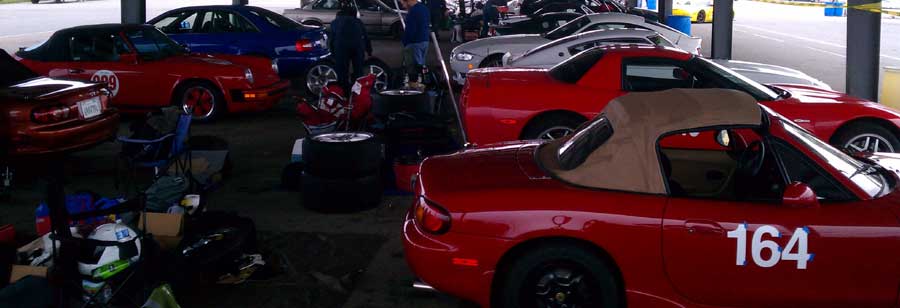
-
Boxes
- The paddock can be a very sunny, windy and sometimes wet place.
The things you remove from your vehicle and leave in the
paddock can be subject to rain-drenching or blowing
away. Put your loose items in boxes to keep them
organized and in place. The paddock is generally a
safe place to leave stuff, as everyone has tools, notebook
PCs, cameras, phones, radar detectors, helmets, race
clothing, etc. However, the "out-of-sight,
out-of-mind" approach to protecting your gear is never
a bad idea and copier paper boxes are great for that.
-
What to
Take - The list of items to pack can be extensive.
You can't take everything, but essential items can save you
time, money, and hassle. Here's our
list of items that fit in the Miata.
-
The Day
and Night Before - Drink plenty of water. The
track environment requires deep hydration. It really
helps to start a week early. Think about
what you are going to eat and drink at the track. Are
you taking a cooler, or will the event organizer provide
mass quantities? Is there a restaurant at the
track? Get plenty of rest so you can get up early and
take your time in the morning. Find out what time the
gates open and plan to be there early to get your vehicle parked,
emptied and ready. It's likely there will be a
mandatory driver's meeting. Be sure you know exactly
where it is held and what time it starts.
-
The
Morning Of - You've done a great job with preparation
and, after a great night of rest, you got up early and are now ready for your track
day. Grab a light breakfast. Top off your fuel
and get to the track. Do you
have friends to paddock with? If traveling together,
start your caravan early. Don't aggravate the locals
on the way to, or back from, the track (no tickets). Locals
don't all love the track and speeding drivers, on their way in
and out, are a constant aggravation for them. The track
managers, event organizers, and neighbors appreciate your
indulgence. Find your parking
spot. Look for a spot that
provides any kind of shelter from sun, wind, or rain. A
spot close to the restaurant, meeting rooms, tire shop, hot
pit entrance, etc., might be a priority. Be aware and drive slowly
in the paddock. Early in the morning, there will be
lots of people milling about and stuff rolling off trailers.
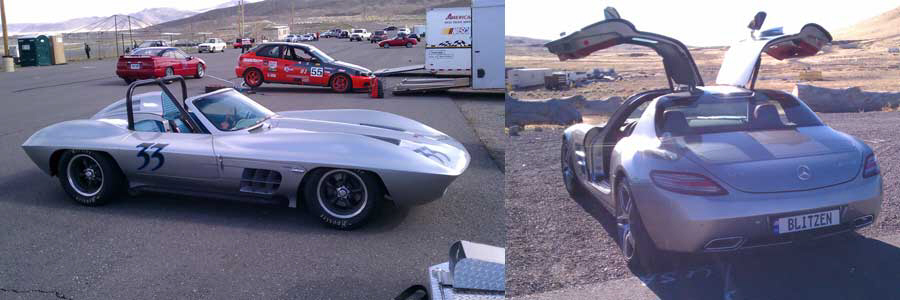
-
In the
Paddock - The earlier you arrive, the wider your choice
of parking spots. Once you are parked, you'll have some time
before the driver's meeting. Don't be late to the
meeting, but use
the time to make final preparations for the first
session. If you haven't done so already, put on your
numbers, empty the vehicle and place your stuff where nobody
will drive over it. Locate and keep easy access to
your tire temp and pressure gauges. You will be using
them immediately after each session. Check and record
your temps and pressures now. Check your lug nut torque.
Check all fluid levels and reservoir caps. Now is a
good time to apply protective tape to any surfaces that are
subject to rock chips, such as the front of your side
mirrors, headlight lenses, driving lamps, fender edges,
etc. If you use
sunscreen, slather up. Check out the paddock, hot pit
entrance/exits, and track entrance/exits.
-
The
Driver's Meetings - The
"driver's meeting" is where the organizer will outline
the events of the day, cover general rules, operations, and
address any questions. Sit where you can hear, see well,
and pay close
attention, especially if you are a novice. Each track
and event organizer will have their individual peculiarities.
Clarify everything; ask any and all questions you
have. Make sure you understand everything. Generally,
the driver's meeting is divided into two parts; a
general meeting, and another specifically for each run group
(novice, intermediate, advanced, race). Attend your group's
meeting after the general meeting. At the end of the
meeting, the meeting-holder, or group leader, might hand out colored stickers
to be affixed to your vehicle, which indicate your group
type and also serve as proof that you attended the driver's meeting. No sticker,
no driving. Multiple drivers, in different groups,
using the same vehicle, each will receive a sticker for their individual
group.
-
Don't
Worry...Be Happy! - Universally, organizers want you to
have a great experience. That means a safe and fun
time. They go to great lengths to facilitate that, but
ultimately, we are responsible for our own happiness.
That said, organizers want and expect you to come to them,
if something isn't right. So, if you see something
amiss, or feel something needs changing, discuss it with the
organizers immediately. It's better for all involved
to make improvements as soon as the need is
identified. Everyone benefits, so speak up.
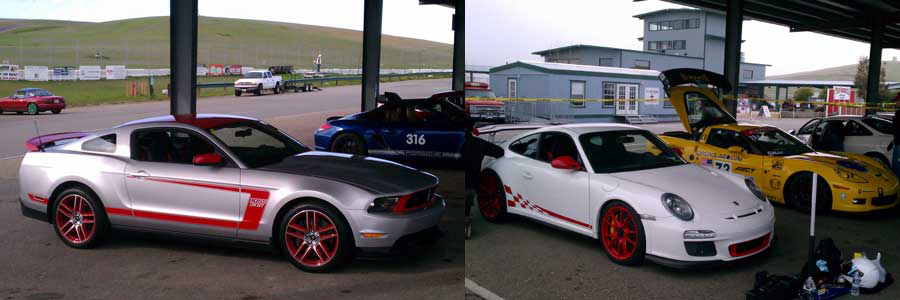
-
The First
Session - Generally, the more advanced groups will run
first. They require less meeting time and are usually
prepared earlier to start running. The novice group
will be attending a longer group meeting. At some
point, you'll be introduced to the instructors, as a group,
or individually, depending on how they are assigned.
After you break from your meeting, you'll have some time to
get ready, but your vehicle should be well prepared before
the general driver's meeting.
-
First
Laps - The first
lap(s) for each group may be run under "full-course caution" (double,
standing, or waiving yellow flag). Your first laps should be used
to warm up the vehicle, tires, and your brain. If you
are new to the track, drive the line and start to pick out your visual queues...the references you will use to identify
your braking points, turn-in, apex, and track-out (corner exit)
points. In many cases, different colored cones will
mark passing zones, braking zones, and corner reference
points.
-
Relax
- It's normal to be nervous about driving on a race course,
especially if this is your first time. Think of the track as just a regular road,
closed for your enjoyment. Don't try to go too fast at
first. You have to go slow to learn the course.
You'll learn a couple of corners at a time, until you have
the entire course memorized. As you start to link
corners together, you can start to build speed.
-
If you
are a novice - You'll probably have an instructor/coach,
if this is your first or second event. Many organizers
strongly suggest that the instructor drive the student's car for
a couple of laps, then come into the hot pits and switch
seats. The instructor should drive a relatively slow
lap, pointing out the flag stands and some of the marks for
your reference. The second lap will be faster - 70-75%
- to give you an idea of what a faster lap feels like.
Don't try to remember everything and don't try to go that
fast. Your job is to learn the line...the speed will
come.
You're brain is in super-sponge-mode and the adrenalin is
probably flowing. The excitement leads to a tendency
to overdrive the track. Don't let it get to you.
If you are "sawing" at the steering wheel, you are
going too fast. Sawing is an indication to the
instructor that the student isn't looking far enough ahead -
probably looking directly at the ground in front of the
vehicle, or directly at the next marker or cone - and isn't sure where to point the car. You
are then likely to hear, "You have to slow down to go
fast."
-
Eyes Up!
- You've studied the basic steps of performance driving -
brake, downshift, turn-in (at corner entry), throttle, apex,
track-out (corner exit). You are focusing on hitting
the marks (possibly cones). However, the tendency is
to be so focused on the marks that you forget to look at the
next mark until it's too late. Now you are
behind. The faster your vehicle, the further ahead you
need to look. Remember, the further ahead you look,
the more likely it is you will drive to that spot. The
trick is to learn how far ahead to look, and what to look
at, from any given
point on the course
-
System
Check - In every lap, there will likely be a point where
you can take a deep breath and relax a little, look at your
instruments, and do a quick personal evaluation. Most
often that point is on the front straight. Get into
the habit of making this type of check on every lap.
-
Cool-Down
Lap - After the checkered flag, you will complete your
lap and pull into the pit/paddock area. Most groups
allow passing after the checkered flag is out...some
don't. Valid reason for and against exist. Drive
your line during the cool-down lap. The goal is to
relax and let the driver, engine, tires, and brakes all cool
off to "normal" operating condition.
-
The
Debrief - After each session, you'll pull into the pit
area and into your parking spot. The instructor might
ask to be dropped off before you park. But, before
getting out of the car, the instructor will discus the
content of the last session, offer explanations, answer any
questions, and make strategy suggestions for the next
session. When you stop, don't set the parking
brake. Turn off the engine and put it in gear to keep
from rolling. Setting the brake can cause hot spots on
brake rotors (leading to warping) and the heat buildup can glaze the
brake pads.
-
After the
Session - This isn't too important for your first
event...you may be talking with an instructor, or heading to a
"download meeting" (see below) directly after your
driving session. If you want
to start learning about your tires, record
tire temps and pressures for future reference. Make
pressure adjustments, if you feel they gained too much
pressure or not enough. Check your "scrub
line". Some vehicles run hot.
You might want to open up engine covers to help ventilate
the area between sessions.
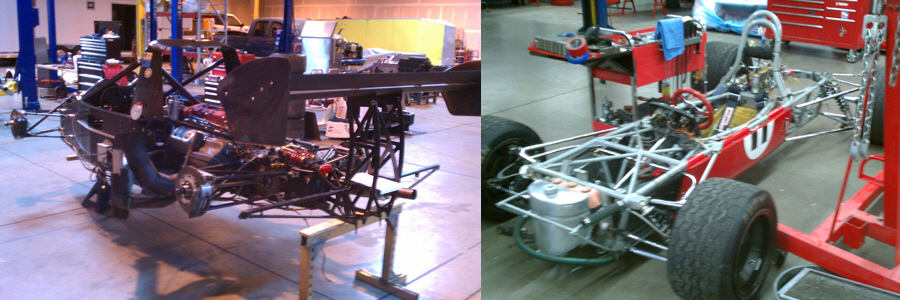
-
Download
Yourself - After each novice session, and perhaps for
other run groups, there's a good chance the organizer will
require you to attend a "download meeting".
In this meeting, you will discuss the events of the
previous driving session, a general goal to work on in the next
session, and address any additional questions you
have. Another sticker my be provided to show you
attended the download.
-
After the
Download - Between cars, karts, trucks, and motorcycles,
there may be 4 or 5 different groups getting on track.
Your download session probably lasted 20-minutes. Each
driving session is 15+ minutes long, so you will be done
with your download and have time to prepare for the next
session. If you haven't already, check your tire
pressure, temperature, and look for cording. Check
your oil and coolant overflow level. Check your fuel
level.
-
Next
Session - Get ready early and don't rush. Meet
your instructor at least 5-mintes before your start
time. For each session, you should have a goal to work
on. If you are a novice, or new to the track, you
should always have two goals in mind - learn the line and be
smooth.
-
Unconscious
Competent? - A little about learning... Commonly
atrributed to Maslow, the "Four Stages for Learning Any
New Skill" was developed by Noel Burch in the 1970s:
Unconscious Incompetent - You don't even know what you need
to know and do.
Conscious Incompetent - You are aware of what you need to
know and do, but don't know it and can't do it.
Conscious Competent - You are aware of what you need to know
and do and have developed capabilities.
Unconscious Competent - Competency is completely automatic.
Unconscious competency is the goal and each skill level can be
categorized. When
an advanced driver goes to a new track, they may be at the
highest level (unconscious competent stage) with regards to
how smooth they are, but at the lower level (unconscious
incompetent, or conscious incompetent stage) with regards to knowing the best line to
drive. A good, street driver may suffer from illusory
superiority and realize they have a lot to learn after their
first day at the track.
-
What to
Learn - If you did your homework, you studied track maps
and watched videos; now you have a leg up on the learning
curve. The most
important part of your leaning process will be to focus on
one visual queue or marker, one line change, or one
technique modification for each session. If you get
it, you can move on. If you don't, you can work on it
again in the next session. Remember, you are there to
have fun, learn, and be safe.
-
After
Subsequent Sessions - Don't set the e-brake. Look
at your fuel level. Check and
record your tire pressures and temps. Look at the
entire surface of the tires for cords showing through.
Check lug nut torque. Inspect your brake rotors and
calipers. Check the oil, all fluid levels, and fuel
level. Leave the engine compartment open for extra
cooling. Attend your download meetings. Hydrate
and snack on low-sugar foods.
-
Lunchtime
- You had a great morning and learned a lot. Find time
for reflection. Think about your sessions and review
what you learned. If you recorded video, review
it. Decide on a few goals and a strategy for the
afternoon. Discuss it with your instructor, or other
drivers. Remember, the primary goal is safe fun.
With fun in mind, every time I get to the track, I ask
myself what will I learn next. I apply some basic
principles to many activities, including track events.
Two are, "fail to plan -- plan to fail" and
"plan your work and work your plan."
-
After
Lunch - Add a full belly to the relaxed condition
experienced after multiple adrenaline-filled events, and you
may find that lethargy is looming large. Especially if
track events are new to you, you may feel fatigued.
Don't push it, if you feel tired. The demanding
environment requires focus and concentration...perhaps more
than accustomed to. Sit out a session and relax.
Talk to instructors and other drivers to get tips and
tricks. Drink plenty of water.
-
The Next
Session - The car is cold. The tires are
cold. The driver is cold. Take it easy for the
first couple of laps. Remember what you learned in the
morning sessions. Recall your lunch strategy goals.
Turn up the speed gently.
-
Recheck
Vitals - You are well into the track event now; it's
time to make sure you are checking the vitals for the car
and the driver. Don't allow yourself to lapse into
complacency, or you might miss an important item. Go
through your check list and self-evaluate your condition.
-
The Last
Session - Be aware of your fatigue level. The last
session is likely where you will be most tired. You've
been spending your tires all day, so traction levels may be
lower. It may be hotter in the afternoon, causing the
tires to "go off" and be "greasy", also
lowering traction. It's likely your fuel level will be
lower. Too low and you may experience fuel starvation
under hard, long cornering.
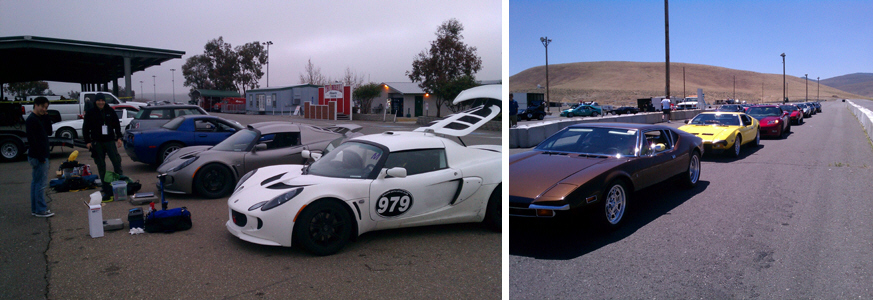
-
Packing
Up - Why doesn't anything fit the same on the way
home? Make sure you pack all your stuff. Return
or recover items borrowed or lent. It's likely you'll
need fuel, if you are driving your track vehicle home.
Check your oil and coolant levels. Check your tires
one last time. Look for cord showing and set the
pressure for normal street operations. Remove tape
over lights. Remove bug guts from (at least) lights
and windscreen.
-
Instant
Feedback - The organizers like to hear that you had a
good time, that you received good training, and that you
would recommend them to others interested in track
events. Take a few moments to share your thought with
the management before heading home. They will
appreciate your feedback and listen to any suggestions for
improvements.
-
Whoa
Baby! - You've been driving at high speeds all
day. It's easy to get out on the road and exceed the
speed limit quickly, just through force of habit. As
stated earlier, the local track neighbors don't appreciate
speeding through their neighborhoods, however
unintentional. The constables will be watching, so be
aware and take it easy.
-
Homeward
Bound - You've said goodbye to your fellow track hounds
and are on the journey home. No doubt, you are a
little tired, so be aware of your condition; rest or drive
accordingly. Keep an eye on engine instruments for any
abnormalities and listen for unusual sounds. You've
been driving hard all day while wearing a helmet, so the
normal audio track might sound a little different.
-
They say
synthetic motor oils are good for 5,000 to 10,000
miles. I change mine after two track days.
-
There may be
a substantially large amount of brake dust built up on the
rims. You'll want to wash this off as soon as
possible. Brake dust can be caustic and damaging to
finished surfaces, particularly to wheels...and especially
if the dust gets wet.
-
.
-
.
-
.
-
.
-
.
-
.
-
.
-
.
-
.
-
.
-
.
-
.
-
.
-
.
-
.
-
.
-
.
-
.
-
.
-
.
-
.
-
.
-
.
-
.
-
.
-
.
-
.
-
.
-
.
-
.
-
.
-
.
-
.
-
.
-
.
-
.
-
.
-
.
-
.
-
.
-
.
-
.
-
.
-
.
-
.
-
.
-
.
-
.
-
.
-
.
-
.
-
|
|
If
you find this information valuable, please link to us and share
our pages.
|
| |
. |



